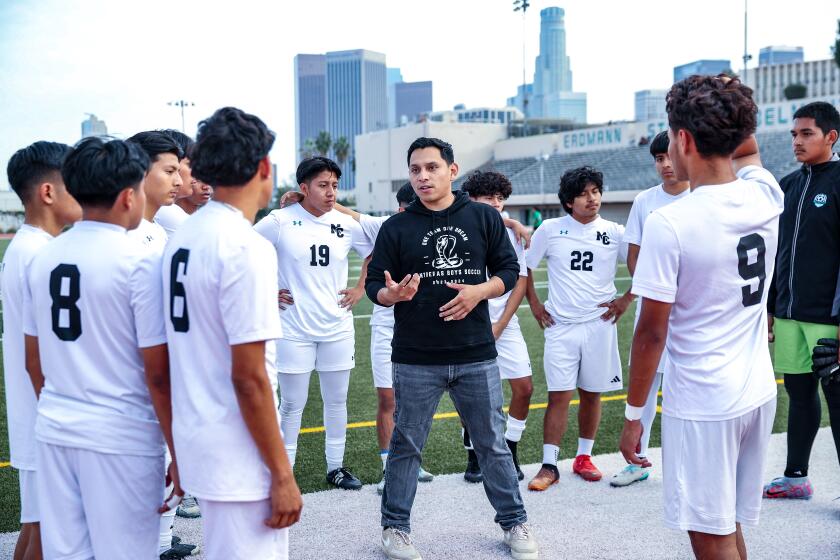Titans to Drop 2 Sports : Cal State Fullerton: Without warning, the men’s gymnastics and women’s volleyball programs are eliminated.
- Share via
FULLERTON — David Stow, the men’s gymnastics coach at Cal State Fullerton, passed women’s volleyball Coach Jim Huffman on the way to work Tuesday morning and said Huffman was “waving and smiling” as he drove by.
Not for long.
Shortly after Huffman arrived at his office, he was informed by Athletic Director Bill Shumard that the women’s volleyball and men’s gymnastics programs were being eliminated for the 1992-93 school year.
The men’s gymnastics team will complete its 24th season in April, and Stow, a first-year coach, will be paid through April 30. Huffman’s contract expired in December, after the Titans went 9-27 in their 12th season, and he will be paid through February.
Shumard said scholarships for student-athletes will be honored through the spring semester, and releases for those wishing to transfer will be granted upon request. But that did little to console several volleyball players, who hugged each other and cried outside Huffman’s office.
“We’re all very shocked--it’s just not fair,” said sophomore Becky Howlett, who has set numerous school records in her two seasons with the Titans. “We didn’t understand why it happened, but it did, so there’s nothing we can do about it.”
But Huffman plans to try. Tuesday afternoon he contacted Berkeley attorney Kirk Boyd, a civil rights expert, who recommended that Huffman seek a temporary restraining order in federal or state court to stop the school from cutting volleyball.
“I don’t think they can legally make the decision,” Huffman said. “I feel like I owe my kids the fight to keep volleyball at Cal State Fullerton.”
According to Boyd there could violations of the California education code, which prohibits discrimination against women’s activities. He also said there could be due process violations--Huffman was never consulted about the decision and didn’t learn of it until Tuesday.
“This came as a total surprise,” the third-year coach said. “There were no rumors of this happening. I’m still totally at a loss as to why this happened except that they need to save money.”
That apparently wasn’t the only reason, Shumard said.
The cuts were part of a new “targeted sports model” for the athletic department that Shumard unveiled Tuesday. The model calls for a re-shifting of priorities and resources, with emphasis placed on what Fullerton does well.
Shumard said five sports--men’s basketball and baseball and women’s basketball, softball and gymnastics--have been targeted as “fully funded” and will be expected to remain competitive on the conference, regional and national levels.
In addition, Shumard said the school remains committed to Division I-A football, which was nearly dropped last year.
Wrestling and soccer will be positioned into a second tier of sports that have consistently competed on at least a regional level and have a strong revenue base.
The other sports--men’s and women’s track and cross-country, men’s and women’s fencing and women’s tennis--will continue to be funded at their current levels, which is to say, they will continue to receive minimal support.
And volleyball and men’s gymnastics?
Well, they were feeling more like targets.
“I love Cal State Fullerton and love working here, but I think they did a really poor job of prioritizing sports,” Huffman said. “How can football, which has won one Division I game in two years, stay at that level, and we get cut when we’ve made progress every year?
“As a department, we’ll go down the drain trying to keep football and let volleyball go, because it’s so important to play Division I football. But I bet if you asked every coach here off the record, they’d say football is the problem.
“I love (football Coach) Gene Murphy and wish we could afford football, but I don’t think it’s fair for a sport with 100 people to tear down a sport with 10 to 12. It’s the revenue sports that don’t produce revenue that kill you.”
But Shumard stressed that though finances were considered--the department’s net savings without the two programs will be about $150,000 a year--the decision was as much philosophical as monetary.
“We came to the conclusion that we were trying to be too many things to too many people,” Shumard said. “We built a model emphasizing what we do well. . . . As tough a day as this is for Fullerton athletics, we’re going forth with a plan we think best fits the university.”
Shumard and associate athletic directors Steve DiTolla, Maryalyce Jeremiah and Larry Zucker spent the past three months formulating the plan, which was endorsed by the Athletics Council and school President Milton Gordon.
Shumard said each sport was evaluated on the same criteria, which included emphasis on the sport by the NCAA and Big West Conference, competitive potential, scheduling opportunities, recruiting base, revenue potential and cost-effectiveness and tradition.
Men’s gymnastics was a relatively easy target. The program, once a national power under former Coach Dick Wolfe, was nearly eliminated in 1990, after which Wolfe’s salary was cut from $63,000 to $33,000. It was almost dropped again in 1991, and its future as an NCAA sport is shaky.
Only 41 schools compete in Division I--one more than the NCAA requires to stage a national championship--and high school boys’ gymnastics teams are virtually nonexistent in Southern California.
“When I took the job, I knew exactly the situation and the possibilities, and I’ve always been prepared for this,” said Stow, 24, an El Dorado High graduate. “But I wasn’t expecting it now.”
Volleyball seemed to fall under the criteria for competitive potential, revenue potential and cost-effectiveness and tradition. The Titans have had only one winning season and have a 17-173 conference record in 12 years.
For volleyball to be competitive in the Big West--which includes national powers Hawaii, UC Santa Barbara, Pacific and Cal State Long Beach--Shumard said it would take a substantial additional investment, one the school is not able to make.
With coaching salaries and scholarships, volleyball cost the school about $130,000 a year. Through fund-raising activities and gate receipts, the sport generated about $35,000-40,000 a year.
After evaluating every sport, “volleyball and men’s gymnastics clearly fell out of the picture,” Shumard said in a release.
Huffman cringed when he read that. “We’re in Southern California, and volleyball is out of the picture?” he said. “It’s the No. 1 sport in California for women. There are more high school volleyball teams than basketball and soccer teams. . . . There are more than 700 NCAA women’s volleyball teams. Clearly, this is an up-and-coming sport.”
What the Titans Are Giving Up
WOMEN’S VOLLEYBALL, playing against some of the country’s toughest competition, had one winning record in 12 years of existence--18-17 in 1981--and never won more than four conference matches (4-14 in the Big West last season). The Titans finished without a conference victory three times, the last in 1988 when they were 0-18.
All-time records: 109-296 (.269 winning percentage), 17-173 conference (.089).
1991: 9-27, 4-14.
Coach: Jim Huffman, third year (25-80). Assistant: Marlon Sano, third year.
Scholarships: 12 at 80% of a full-ride.
MEN’S GYMNASTICS was once an NCAA college division power, winning three national championships under Dick Wolfe, who coached the program for 23 of its 24 years before retiring last year. But the Titans have been in decline the past several seasons and the Big West does not sponsor the sport. Fullerton competes in the Pacific 10 Conference championships.
National team champions: 1971, 1972, 1974 in NCAA college division.
National individual champions: Sam Shaw, vault, 1976; Li Xiao Ping, parallel bars, 1987.
All-Americans: Mike Kelley, parallel bars, 1972; Sam Shaw, vault, 1976; Donny Evins, floor, Ron Howard, vault, 1979; Bill Valaika, parallel bars, 1981; Ric Draghi, vault, Shawn McNulty, rings, Scott Picquelle, parallel bars, 1985; Kenny Johnson, floor, Li Xiao Ping, pommel horse, parallel bars, 1987; Bill Barham, parallel bars, Amir Kadury, high bar, 1988.
1990: 2-2 in dual meets, seventh in Pac-10 championships. Highest NCAA finisher was Diego Lopez, 33rd, vault.
Coach: David Stow (first year). Assistant: Diego Lopez (first year).
Scholarships: The equivalent of less than one full ride.
More to Read
Get our high school sports newsletter
Prep Rally is devoted to the SoCal high school sports experience, bringing you scores, stories and a behind-the-scenes look at what makes prep sports so popular.
You may occasionally receive promotional content from the Los Angeles Times.







